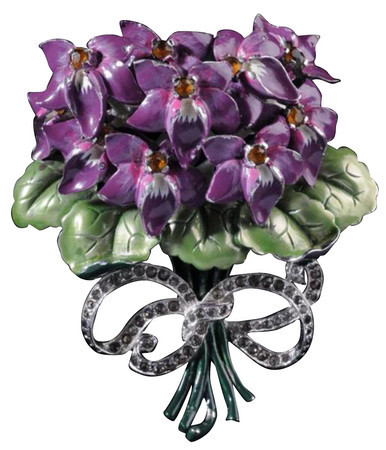Costume jewelry among top collectibles

Costume jewelry is among the best-selling collectibles in the United States today. Much of the costume jewelry made in the mid-20th century is well-designed and was created with materials that have lasted. Pieces usually are more durable and less expensive than modern costume jewelry.
One of the well-known names in costume jewelry of the 1930s to the 1970s is Mazer. Joseph Mazer and his brother Louis founded Mazer Brothers in New York City in about 1927. Their jewelry was marked “Mazer,” “Mazer Bros.” or “Sea-Maze.”
In 1940, they separated and Joseph started Joseph J. Mazer and Co., better known as Jomaz. His company marked jewelry “Jomaz,” “Joseph Mazer” or “Mazer.” It closed in 1981. Louis continued to work for the original company until 1951. That company went out of business in 1977.
Flower pins, ribbon and bow pins featuring colored enamels, faux pearls and Swarovski crystals and rhinestones were among the Mazer brothers’ early designs. Sterling silver, gold-plated sterling and rhodium-plated metal were used in later pieces. All of the brothers’ jewelry was carefully made and sold originally at middle-range prices.
Q: I have an antique artificial leg with a peg foot that I was told dates from the Civil War era. It’s wooden with a hinged metal brace at the knee and a leather case that could be attached above the knee with laces.
A: You will have to take your prosthetic leg to a medical museum in your area to precisely date its origin, but it sounds as though the leg could date from the Civil War era. That’s when battlefield amputations led to extensive research in artificial limbs.
In fact, one of the war’s early amputees, a Confederate soldier from Virginia named James E. Hanger, designed a leg for himself in 1861 and later founded a company to manufacture prosthetic legs. The company, now called Hanger Orthopedic Group, is based in Bethesda, Md., and makes all sorts of prosthetic devises for injured U.S. soldiers.
The value of Civil War-era artificial legs ranges widely depending on several factors, including whether an expert has determined its age. We have seen them sell for hundreds into the low thousands. Some museums accept them as donations.
Q: I have an antique library table that has a mark on the bottom of the desk drawers that says “Wolverine, Detroit, 1887.” What can you tell me about this company?
A: The Wolverine Manufacturing Co. was organized by Frederick B. Smith in 1887. He started the furniture company with 12 men and $10,000. The company specialized in manufacturing library and parlor tables. By 1908 Wolverine claimed to be the largest manufacturer of its kind in the world. The company was out of business by 1919.
An average-quality library table by a maker that is not well-known is worth about $300 to $500 — in other words, it’s worth its “use” value.
Q: I have a vase with a circular mark on the bottom that includes the words “Arequipa, California” around a drawing of a vase under a tree. It has been in the family for years. Is it valuable?
A: Arequipa Pottery was made by patients at the Arequipa Sanatorium in Marin County, Calif., from 1911 to 1918. The sanatorium treated women and girls with tuberculosis. The pottery was established to give the patients something to do.
Patients were taught by Frederick Hurten Rhead, a well-known potter who had worked at Roseville Pottery. Your vase has an early mark used when Rhead was there, from 1911 until 1913.
Arequipa Pottery with this mark brings the highest prices today. Vases sell for hundreds to thousands of dollars.
Terry Kovel’s column is syndicated by King Features. Write to: Kovels, (Las Vegas Review-Journal), King Features Syndicate, 300 W. 57th St., New York, NY 10019.












